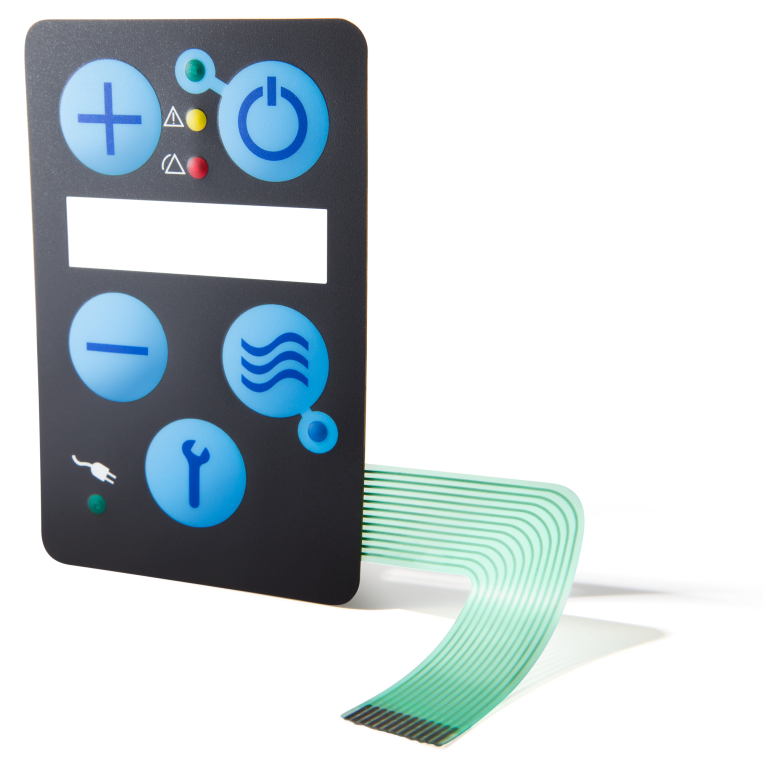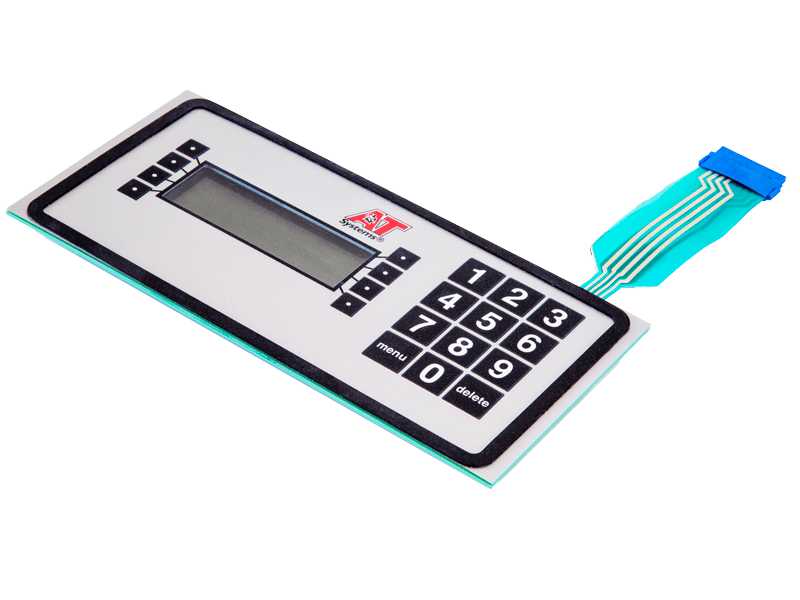Membrane Switch Manufacturer Providing Durable and High-End Interfaces
Wiki Article
Understanding the Value of Membrane Switch in Modern Electronic Devices and Their Applications
Membrane switches over serve as a crucial component in contemporary electronic devices, providing a reliable interface for individual communication. Their customizable and lightweight nature makes them appropriate for an array of applications throughout diverse markets. Comprehending their crucial components and advantages can give insights into their expanding importance. As technology proceeds to advance, the development of Membrane switches over questions concerning their future applications and layout developments. What exists in advance in this vibrant area?
What Are Membrane Buttons?
Membrane switches are essential parts in contemporary electronics, working as individual interfaces that facilitate communication between users and tools. These switches contain numerous layers, consisting of a graphic overlay, a glue layer, and a circuit layer, all of which job together to develop a long lasting and functional user interface. The design permits a flat, inconspicuous service that can be tailored relating to dimension, form, and aesthetic appearance, making them ideal for different applications, from customer electronics to medical devices. The tactile responses offered by Membrane switches improves customer experience, while their resistance to dust and wetness makes them perfect for testing environments. Membrane buttons can include features such as backlighting and printed graphics, further increasing their use. Their flexibility and toughness make them a recommended choice in markets where dependability and convenience of use are extremely important, inevitably adding to the smooth procedure of modern-day electronic gadgets.Key Parts of Membrane Switches Over
While various components add to the functionality of a membrane button, 3 main layers play considerable duties in its layout and procedure. The top layer, generally made from a resilient polymer, functions as the interface for user interaction, often featuring published graphics and symbols. Under this is the spacer layer, which keeps the essential range in between the top layer and the circuit layer. This spacer layer assurances that the button turns on just when pressed, stopping unexpected inputs. The circuit layer contains conductive traces that finish the electrical circuit when the leading layer is dispirited. These traces can be made from numerous products, including copper or silver. Together, these elements produce a robust and dependable tool that is small and versatile, suitable for a large range of digital applications, from family home appliances to medical tools. Recognizing these vital elements is important for appreciating the total performance of Membrane buttons.Advantages of Utilizing Membrane Switches Over

Membrane Switch Production Process
Recognizing the Membrane switch manufacturing procedure reveals the detailed steps associated with creating these important elements. The process normally begins with the layout phase, where formats and specifications are produced making use of specialized software application. Following this, the visuals overlay is printed on an adaptable substrate, commonly using high-resolution printing methods to guarantee clearness and precision.Next, the sticky layers are applied, which serve to bond the numerous elements together. The circuit layers, made from conductive inks or materials, are after that published onto a different substrate. These layers are very carefully aligned and laminated to develop a functional switch.After assembly, the buttons undertake testing to verify capability and resilience. Quality assurance actions are executed throughout the process to recognize and fix any problems. The completed Membrane buttons are packaged and prepared for distribution, prepared to fulfill the demands of contemporary digital applications.Applications of Membrane Switches in Numerous Industries
Membrane switches are significantly made use of throughout various markets, especially in clinical tools and customer electronic devices. In the clinical area, they give reliable control user interfaces for gadgets that call for precise operation. Similarly, in consumer electronics, these buttons boost customer interaction by offering sleek and receptive user interfaces.
Medical Equipment Control
Countless modern-day clinical gadgets utilize Membrane buttons for streamlined operation and boosted individual interaction. These buttons offer a trusted, sturdy interface for a variety of applications, consisting of diagnostic equipment, person tracking systems, and surgical instruments. Their personalized styles permit specific designs that can accommodate the unique demands of healthcare professionals, making sure user-friendly navigation and effective access to essential features. Additionally, Membrane switches are immune to contaminants, making them ideal for sterilized settings. The tactile responses they provide can boost individual self-confidence, minimizing the risk of mistakes during crucial clinical procedures. On the whole, the integration of Membrane buttons in medical tools significantly adds to enhanced functional efficiency and individual safety and security in health care setups.Customer Electronics Interfaces
In the domain name of consumer electronic devices, Membrane switches play an essential duty in enhancing individual interfaces throughout a wide variety of tools. These switches are integral to products such as push-button controls, microwaves, and pc gaming consoles, providing a effective and user-friendly interface. Their style permits a seamless integration of graphics and functionality, allowing makers to develop smooth, modern aesthetic appeals without endangering use. Membrane buttons are also known for their sturdiness, commonly holding up against extensive use and exposure to various environmental conditions. Additionally, they can incorporate features like backlighting and tactile feedback, more boosting the user experience. As customer needs for advanced yet user-friendly interfaces grow, Membrane changes see this page continue to be an essential component in advancing electronic device performance.Design Considerations for Membrane Changes
Creating reliable Membrane changes calls for mindful focus to different elements that influence both functionality and customer experience. One crucial factor to consider is the choice of materials, as they can influence toughness, tactile feedback, and visual charm. Selecting a suitable adhesive is essential for assuring lasting bond and resistance to environmental factors.In enhancement, the design and design of the button need to accommodate customer interaction, with button sizes and spacing optimized for convenience of use. The unification of graphics and labeling must prioritize quality and visibility under various lights conditions.Consideration of electric attributes, such as actuation pressure and button sensitivity, will improve the responsiveness of the Membrane switch. Additionally, the layout needs to suit manufacturing procedures to ensure cost-effectiveness and prompt manufacturing. Overall, a well-balanced style boosts both the customer and the functionality experience of Membrane switches in modern-day electronics.
Future Trends in Membrane Switch Technology
As technology proceeds to advance, Membrane switches are poised to incorporate new improvements that will certainly enhance their capability and application in various fields. One considerable pattern is the unification Recommended Site of adaptable and resilient materials, which will enhance the life expectancy and dependability of these buttons. Improved surface area appearances and personalized graphics are additionally prepared for, permitting more instinctive individual interfaces.Moreover, the assimilation of wise modern technology, such as touch-sensitive surfaces and haptic feedback, is anticipated to improve user interaction, making Membrane switches much more responsive and engaging. In addition, developments in printed electronic devices will certainly make it possible for much more complex circuitry within thinner accounts, additionally increasing design possibilities.Sustainability will certainly additionally play an essential duty in future growths, as makers check out environment-friendly materials and production procedures. On the whole, these patterns will guarantee that Membrane changes remain indispensable and pertinent in a significantly electronic and interconnected world.Regularly Asked Concerns
How Do Membrane Changes Compare to Conventional Mechanical Switches?
Membrane changes offer benefits over standard mechanical switches, consisting of reduced dimension, lighter weight, and enhanced resilience. They typically supply a sealed surface area, enhancing resistance to dirt and moisture, making them excellent for diverse applications.What Products Are Typically Made Use Of in Membrane Switch Construction?

Can Membrane Changes Withstand Extreme Environmental Conditions?
Membrane buttons can stand up to extreme ecological conditions, relying on their design and products. Premium building and constructions commonly feature longevity against temperature level fluctuations, moisture, and exposure to chemicals, making them appropriate for numerous demanding applications throughout markets.The Length Of Time Do Membrane Changes Generally Last Prior To Failure?
Membrane switches over generally display a life-span ranging from 1 to 10 million actuations, depending on variables such as usage regularity, ecological conditions, and manufacturing high quality. Normal upkeep can extend their sturdiness and functional integrity significantly.Are Membrane Changes Personalized for Particular Applications?
Membrane switches are indeed customizable for particular applications. They can be customized in design, performance, and dimension, enabling makers to fulfill one-of-a-kind customer requirements and boost item visual appeals while preserving operational effectiveness and sturdiness. Membrane switches are vital elements in contemporary electronics, serving as user interfaces that assist in communication between devices and users. The responsive responses supplied by Membrane switches enhances customer experience, while their resistance to dirt and dampness makes them ideal for testing settings. The consolidation of graphics and labeling ought to prioritize quality and exposure under different lighting conditions.Consideration of electric attributes, such as actuation force and button level of sensitivity, will certainly improve the responsiveness of the Membrane button. Improved surface appearances and adjustable graphics are also prepared for, enabling for more instinctive individual interfaces.Moreover, the assimilation of review smart technology, such as touch-sensitive surface areas and haptic comments, is expected to boost user communication, making Membrane changes much more engaging and receptive. Membrane switches over offer benefits over conventional mechanical buttons, including lowered size, lighter weight, and boosted toughness.Report this wiki page